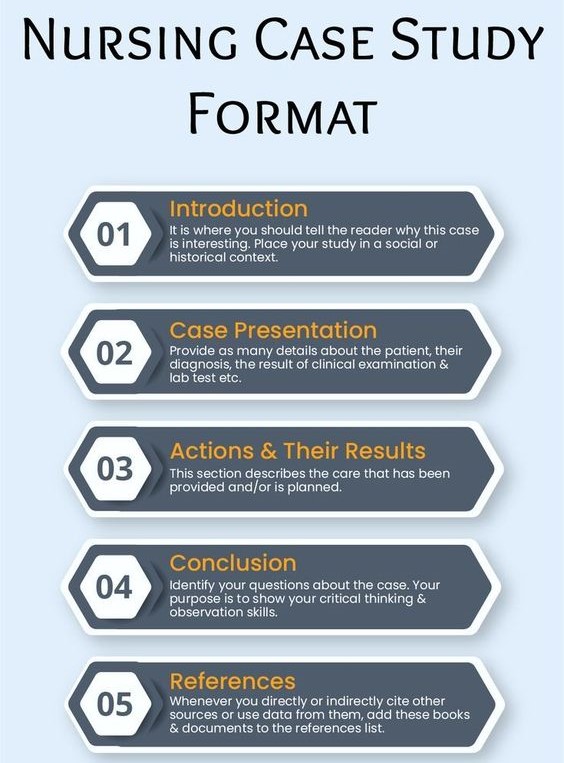
Table of Contents
Nursing case studies are powerful tools for learning, critical thinking, and professional development. They allow nurses to delve into real-world patient scenarios, analyze complex situations, and apply their knowledge to formulate effective care plans. While the process might seem daunting, writing a compelling nursing case study can be accomplished through meticulous planning, engaging storytelling, and adherence to specific guidelines.
This comprehensive guide will equip you with the knowledge and skills necessary to create a valuable and impactful nursing case study.
Understanding the Purpose and Structure of a Nursing Case Study
The Purpose of Nursing Case Studies
- Facilitate Learning: Case studies provide a platform for students and practicing nurses to apply theoretical knowledge to real-world situations. They help in understanding the complexities of patient care and developing critical thinking skills.
- Foster Discussion and Debate: Case studies often present ethical dilemmas or challenging patient scenarios, stimulating discussions and encouraging diverse perspectives among nurses.
- Document Best Practices: Case studies can showcase exemplary nursing care, highlighting innovative approaches and best practices for others to learn from.
- Evaluate Nursing Interventions: By analyzing patient outcomes, case studies can evaluate the effectiveness of nursing interventions and inform future care practices.
- Advance Nursing Research: Well-constructed case studies can contribute to the body of nursing knowledge by providing insights into patient experiences and emerging trends.
The Structure of a Nursing Case Study

A typical nursing case study follows a standard structure as outlined below:
- Introduction: Briefly introduce the topic, their presenting problem, and the purpose of the case study. This section should grab the reader’s attention and establish the context of the entire paper.
- Patient History: Provide a comprehensive account of the patient’s medical history, including relevant past illnesses, surgeries, medications, allergies, and family history.
- Presenting Problem: Describe the current health issue or concern that led to the patient’s admission or seeking care. This should include a detailed account of symptoms, onset, and progression.
- Physical Assessment: Present a thorough assessment of the patient’s vital signs, physical examination findings, and laboratory results relevant to the presenting problem.
- Nursing Diagnosis: Formulate one or more nursing diagnoses based on the patient’s assessment data and the identified health problem.
- Nursing Interventions: Outline the specific actions taken by the nurse to address the patient’s needs and manage their condition. Include detailed descriptions of interventions, rationale, and frequency.
- Evaluation: Analyze the patient’s response to the nursing interventions and assess their progress towards desired outcomes. Include objective data and subjective feedback from the patient.
- Discussion: Analyze the case study in detail, exploring the challenges, ethical considerations, and potential alternative approaches to care. This section should provide insightful reflections and critical analysis.
- Conclusion: Summarize the key learning points from the case study and highlight the relevance of the presented information to nursing practice.
Writing Your Nursing Case Study: A Step-by-Step Guide
Choose a Relevant and Compelling Topic
- Identify an area of interest: Select a topic that aligns with your personal interests, professional goals, or current clinical experiences.
- Consider patient demographics: Choose a patient population that you have worked with or have a strong interest in.
- Focus on a specific health problem: Narrow down the topic to a specific disease, condition, or health issue that presents a unique nursing challenge.
- Ensure ethical considerations: Ensure that the case study does not reveal any confidential patient information or breach ethical guidelines.
Gather and Organize Information
- Access patient charts: Obtain the necessary medical records, including admission notes, progress notes, medication records, laboratory results, and diagnostic reports.
- Interview the patient (if applicable): Gather information directly from the patient about their experience, preferences, and understanding of their condition.
- Consult with other healthcare providers: Seek insights from physicians, specialists, or other nurses involved in the patient’s care.
- Review relevant literature: Explore existing research and evidence-based practice guidelines related to the patient’s health problem and nursing interventions.
- Organize your findings: Create a structured format for your notes, separating patient history, physical assessment, interventions, and evaluation data.
Develop a Clear and Concise Writing Style
- Use plain language: Avoid technical jargon and acronyms, ensuring that the case study is accessible to a broad audience.
- Maintain objectivity: Present the facts in an unbiased manner, avoiding personal opinions or value judgments.
- Use proper grammar and punctuation: Pay attention to grammar, spelling, and punctuation to enhance readability and professionalism.
- Keep it focused: Stick to the relevant information and avoid irrelevant details or tangents.
- Use headings and subheadings: Break down the case study into logical sections with clear headings and subheadings to improve readability.
Use Engaging Storytelling Techniques
- Introduce the patient as a person: Describe the patient’s background, personality, and individual experiences to humanize the case study.
- Use vivid language: Employ descriptive language and sensory details to paint a picture of the patient’s condition and their response to care.
- Emphasize the patient’s perspective: Include the patient’s own voice through direct quotes or paraphrasing to convey their feelings, concerns, and understanding of their situation.
- Show, don’t tell: Instead of stating facts, demonstrate the patient’s condition through their actions, behaviors, and physical observations.
- Highlight the nurse’s role: Showcase the nurse’s knowledge, skills, and compassion in providing care for the patient.
Address Ethical Considerations:
- Obtain informed consent: Ensure that you have obtained informed consent from the patient or their legal representative before including their information in the case study.
- Protect patient privacy: De-identify the patient by using initials or fictitious names to ensure confidentiality.
- Respect patient autonomy: Present the case study in a manner that respects the patient’s wishes and avoids disclosing sensitive or personal details.
- Maintain professional boundaries: Avoid disclosing any identifying information about other healthcare providers or the patient’s family members.
- Consider potential bias: Be mindful of your own biases and perspectives, ensuring that the case study reflects a balanced and objective portrayal of the patient’s care.
Incorporate Relevant Resources:
- Provide references: Support your statements with evidence-based literature, citing relevant sources using a consistent referencing style (e.g., APA, MLA).
- Use tables and figures: Employ visual aids such as tables, charts, and graphs to present complex data in an easy-to-understand manner.
- Include images (if appropriate): Consider incorporating relevant images, such as photographs of medical equipment or patient monitoring devices, to enhance the visual appeal of the case study.
Revise and Edit Thoroughly:
- Seek feedback from peers and mentors: Request input from other nurses or faculty members to improve the clarity, accuracy, and objectivity of your case study.
- Proofread carefully: Check for any errors in grammar, spelling, and punctuation.
- Ensure consistency: Verify that your case study adheres to the specified format and referencing style guidelines.
Tips for Writing a High-Quality Nursing Case Study

- Focus on a single patient and a specific health problem.
- Use a clear and concise writing style that is easy to understand.
- Emphasize the patient’s perspective and experience.
- Include a thorough discussion of the nursing interventions and their rationale.
- Analyze the patient’s response to care and evaluate the effectiveness of the interventions.
- Identify any ethical considerations or dilemmas related to the case.
- Draw conclusions that are relevant to nursing practice and patient care.
- Provide references to support your statements and ensure accuracy.
- Seek feedback from peers and mentors before submitting your case study.
Examples of Nursing Case Studies
- A Case Study of a Patient with Chronic Obstructive Pulmonary Disease (COPD): This case study could focus on a patient with COPD who is experiencing an exacerbation. It could explore the nurse’s role in assessing the patient’s respiratory status, providing oxygen therapy, and teaching the patient about self-management techniques.
- A Case Study of a Patient with Heart Failure: This case study could focus on a patient with heart failure who is admitted to the hospital with fluid overload. It could explore the nurse’s role in monitoring the patient’s hemodynamic status, administering diuretics, and educating the patient about lifestyle modifications.
- A Case Study of a Patient with Type 2 Diabetes: This case study could focus on a patient with type 2 diabetes who is experiencing hyperglycemia. It could explore the nurse’s role in assessing the patient’s blood glucose levels, administering insulin, and teaching the patient about diet and exercise.
The Bottom Line
Crafting a compelling nursing case study involves meticulous planning, engaging storytelling, and adherence to specific guidelines. By following the steps outlined in this guide, students and nurses can develop valuable learning tools that contribute to the advancement of nursing career and enhance patient care. Remember, a strong nursing case study should provide a detailed account of a patient’s experience and, also offer insightful reflections, critical analysis, and valuable lessons for future nursing interventions.
At phdnursewriter, we offer professional assignment writing help for all types of nursing papers including case studies, essays and dissertations. We guarantee a top notch nursing case study that will truly elevate your grades.





